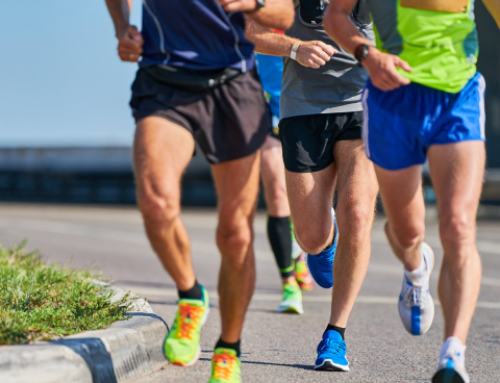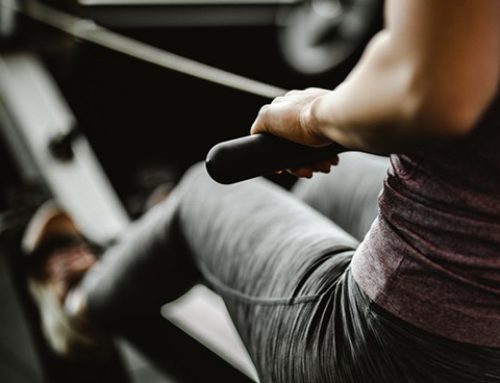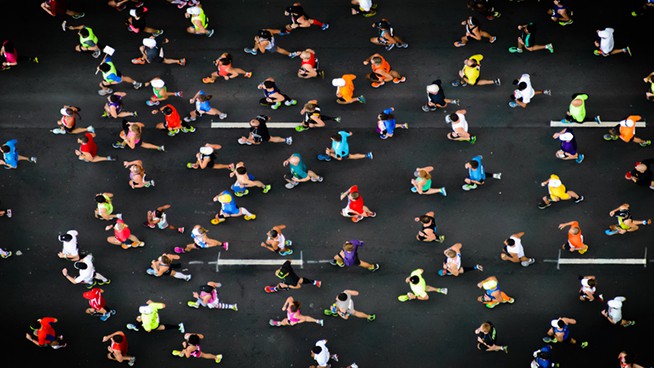Plyometric Exercises for Runners
Picture yourself on the starting line of a race. You’re in the blocks. You pull back to create eccentric motion in the lower leg before firing forward to victory. Now imagine yourself being able to shoot off even further. Want to know how? With plyometric training, which is beneficial for all track & field athletes, regardless of the event.
Those instinctive motions you go through before a race directly reflect plyometric training. Plyometric exercises develop a muscle’s stretch-shortening cycle—when the muscle actively relaxes before a more forceful contraction. During the active relaxation phase, energy is stored and then shot off—like snapping a rubber band—to forcefully contract the muscle and tendon group.
The following workout will improve your overall race times.
Before you begin, review these guidelines:
- Each exercise should be done at full speed.
- Give yourself plenty of rest to recover between reps.
- This workout should take 45 minutes, including the warm-up.
- To effectively train plyometrically, limit the amount of time you are on the ground. Try to land and re-jump as quickly as possible.
- Think explosive. These exercises are high impact, so they should not be done for endurance training.
- Limit your ground strikes to no more than 200 in the beginning. Eventually, you can work your way up to 500 touches in a workout.
- The heavier you are, the harder it will be to recover. If you weigh 200 pounds or more, give yourself at least 3 days to recover before your next plyometric training session.
Runner’s Plyometric Workout
Always begin with a dynamic warm-up.
Ankle Hops – 3×10 (cumulative foot touches: 30)
- Jump up and down bending only at the ankles
- Keep your knees and hips in with the rest of your body
Knee Tucks – 2×10 (cumulative foot touches: 50)
- Jump up and down, bringing your knees towards your chest at the top of the jump
Bounding- 2×20 (cumulative foot touches: 90)
- Start running, but leap into the air, extend your knees and reach for as long as your stride allows
Dynamic Lunges – 2×10 (cumulative foot touches: 130)
- Start in a lunge position
- Explode up and switch your legs
- Land in a soft position with your knees flexed and out
Depth Jumps – 2×20 (cumulative foot touches: 150)
- Stand on 12- to 16-inch box
- Step off the box and touch ground with both feet together
- Make sure your knees don’t cave in and that you have proper alignment in your knees and hips
- Jump back up onto another box and land in a flexed knee position or a half squat
Kneeling to Standing Explosive Jump – 3×10 (cumulative foot touches: 180)
- Kneel on a pad or on the floor.
- Drop the hips lower and explode upwards
- Flex the knees and the hips and land on your feet in a half-squat position.
Kneeling to Standing Explosive Jump to Sprint – 2×10 (cumulative foot touches: 200)
- Repeat the previous exercise but when you land, immediately sprint forward ten yards
READ MORE:
RECOMMENDED FOR YOU
MOST POPULAR
Plyometric Exercises for Runners
Picture yourself on the starting line of a race. You’re in the blocks. You pull back to create eccentric motion in the lower leg before firing forward to victory. Now imagine yourself being able to shoot off even further. Want to know how? With plyometric training, which is beneficial for all track & field athletes, regardless of the event.
Those instinctive motions you go through before a race directly reflect plyometric training. Plyometric exercises develop a muscle’s stretch-shortening cycle—when the muscle actively relaxes before a more forceful contraction. During the active relaxation phase, energy is stored and then shot off—like snapping a rubber band—to forcefully contract the muscle and tendon group.
The following workout will improve your overall race times.
Before you begin, review these guidelines:
- Each exercise should be done at full speed.
- Give yourself plenty of rest to recover between reps.
- This workout should take 45 minutes, including the warm-up.
- To effectively train plyometrically, limit the amount of time you are on the ground. Try to land and re-jump as quickly as possible.
- Think explosive. These exercises are high impact, so they should not be done for endurance training.
- Limit your ground strikes to no more than 200 in the beginning. Eventually, you can work your way up to 500 touches in a workout.
- The heavier you are, the harder it will be to recover. If you weigh 200 pounds or more, give yourself at least 3 days to recover before your next plyometric training session.
Runner’s Plyometric Workout
Always begin with a dynamic warm-up.
Ankle Hops – 3×10 (cumulative foot touches: 30)
- Jump up and down bending only at the ankles
- Keep your knees and hips in with the rest of your body
Knee Tucks – 2×10 (cumulative foot touches: 50)
- Jump up and down, bringing your knees towards your chest at the top of the jump
Bounding- 2×20 (cumulative foot touches: 90)
- Start running, but leap into the air, extend your knees and reach for as long as your stride allows
Dynamic Lunges – 2×10 (cumulative foot touches: 130)
- Start in a lunge position
- Explode up and switch your legs
- Land in a soft position with your knees flexed and out
Depth Jumps – 2×20 (cumulative foot touches: 150)
- Stand on 12- to 16-inch box
- Step off the box and touch ground with both feet together
- Make sure your knees don’t cave in and that you have proper alignment in your knees and hips
- Jump back up onto another box and land in a flexed knee position or a half squat
Kneeling to Standing Explosive Jump – 3×10 (cumulative foot touches: 180)
- Kneel on a pad or on the floor.
- Drop the hips lower and explode upwards
- Flex the knees and the hips and land on your feet in a half-squat position.
Kneeling to Standing Explosive Jump to Sprint – 2×10 (cumulative foot touches: 200)
- Repeat the previous exercise but when you land, immediately sprint forward ten yards
READ MORE:










